Strategic Planning Report: Vista Company Strategic Direction Analysis
VerifiedAdded on 2023/01/20
|15
|4576
|85
Report
AI Summary
This report delves into the core concepts of strategic planning, exploring the interrelationships between organizational vision, mission, strategy, and business plans. Using Vista Company, a technology solutions provider, as a case study, the report analyzes external factors impacting organizations, evaluates stakeholder expectations, and examines the importance of reviewing strategies and business plans. The analysis includes evaluating tools for strategic review, analyzing strategy options, and exploring the structure of a plan needed to deliver the strategy, including stakeholder involvement and dissemination processes. The report emphasizes the impact of these elements on organizational direction and success, highlighting the importance of adapting to external factors and managing stakeholder expectations effectively. The report underscores the importance of a well-defined strategic planning process to ensure organizational growth and development.
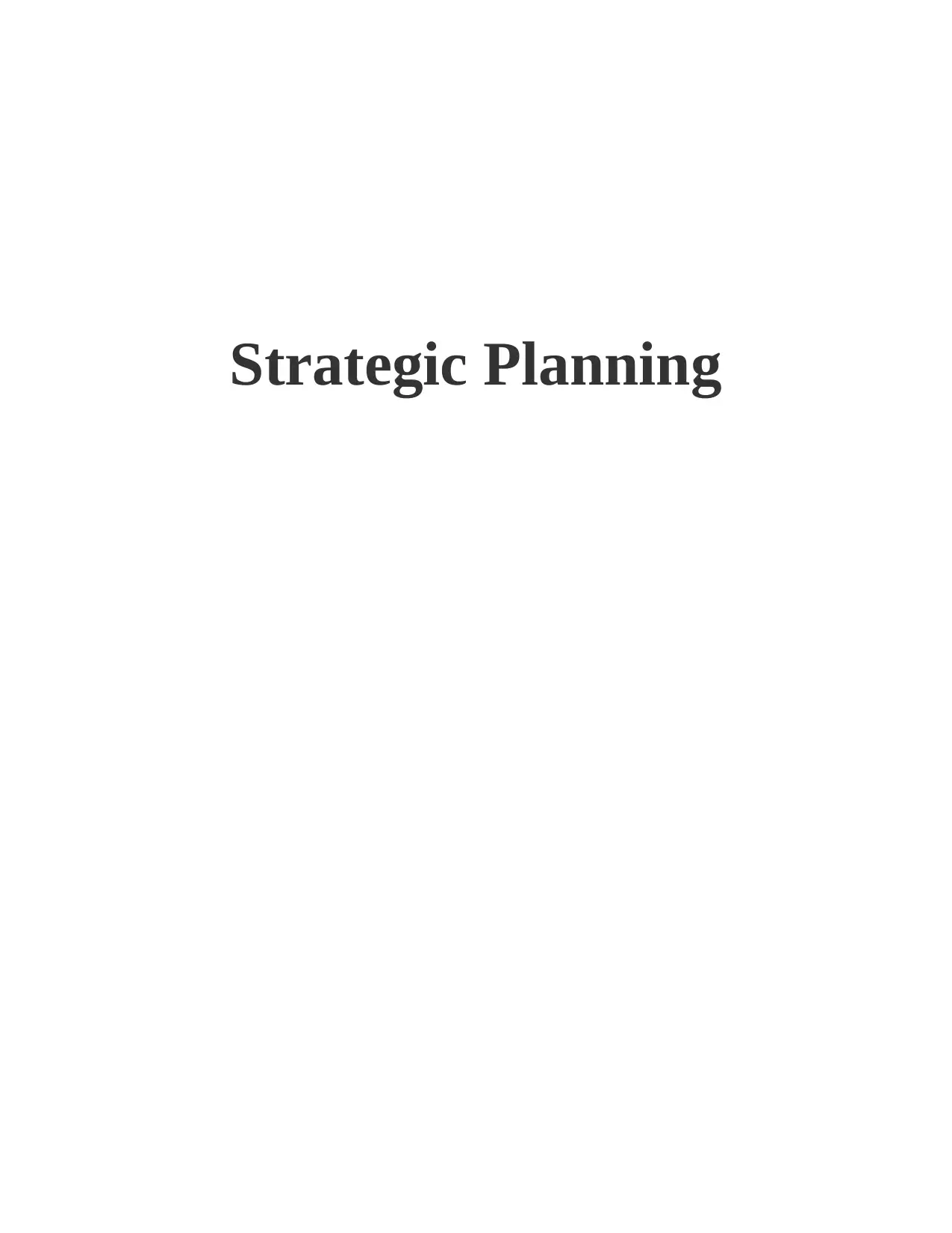
Strategic Planning
Paraphrase This Document
Need a fresh take? Get an instant paraphrase of this document with our AI Paraphraser
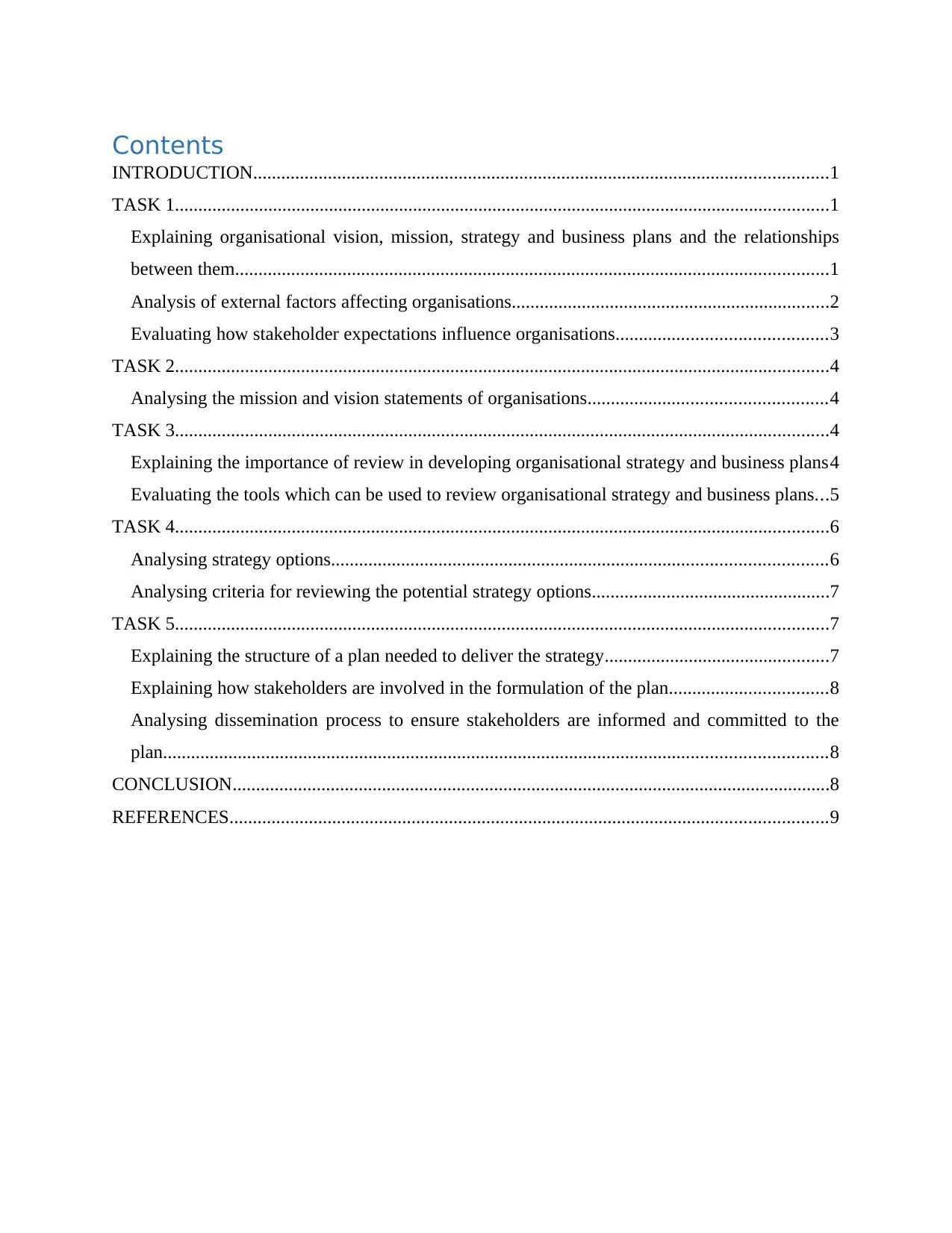
Contents
INTRODUCTION...........................................................................................................................1
TASK 1............................................................................................................................................1
Explaining organisational vision, mission, strategy and business plans and the relationships
between them...............................................................................................................................1
Analysis of external factors affecting organisations....................................................................2
Evaluating how stakeholder expectations influence organisations.............................................3
TASK 2............................................................................................................................................4
Analysing the mission and vision statements of organisations...................................................4
TASK 3............................................................................................................................................4
Explaining the importance of review in developing organisational strategy and business plans4
Evaluating the tools which can be used to review organisational strategy and business plans...5
TASK 4............................................................................................................................................6
Analysing strategy options..........................................................................................................6
Analysing criteria for reviewing the potential strategy options...................................................7
TASK 5............................................................................................................................................7
Explaining the structure of a plan needed to deliver the strategy................................................7
Explaining how stakeholders are involved in the formulation of the plan..................................8
Analysing dissemination process to ensure stakeholders are informed and committed to the
plan..............................................................................................................................................8
CONCLUSION................................................................................................................................8
REFERENCES................................................................................................................................9
INTRODUCTION...........................................................................................................................1
TASK 1............................................................................................................................................1
Explaining organisational vision, mission, strategy and business plans and the relationships
between them...............................................................................................................................1
Analysis of external factors affecting organisations....................................................................2
Evaluating how stakeholder expectations influence organisations.............................................3
TASK 2............................................................................................................................................4
Analysing the mission and vision statements of organisations...................................................4
TASK 3............................................................................................................................................4
Explaining the importance of review in developing organisational strategy and business plans4
Evaluating the tools which can be used to review organisational strategy and business plans...5
TASK 4............................................................................................................................................6
Analysing strategy options..........................................................................................................6
Analysing criteria for reviewing the potential strategy options...................................................7
TASK 5............................................................................................................................................7
Explaining the structure of a plan needed to deliver the strategy................................................7
Explaining how stakeholders are involved in the formulation of the plan..................................8
Analysing dissemination process to ensure stakeholders are informed and committed to the
plan..............................................................................................................................................8
CONCLUSION................................................................................................................................8
REFERENCES................................................................................................................................9

⊘ This is a preview!⊘
Do you want full access?
Subscribe today to unlock all pages.

Trusted by 1+ million students worldwide
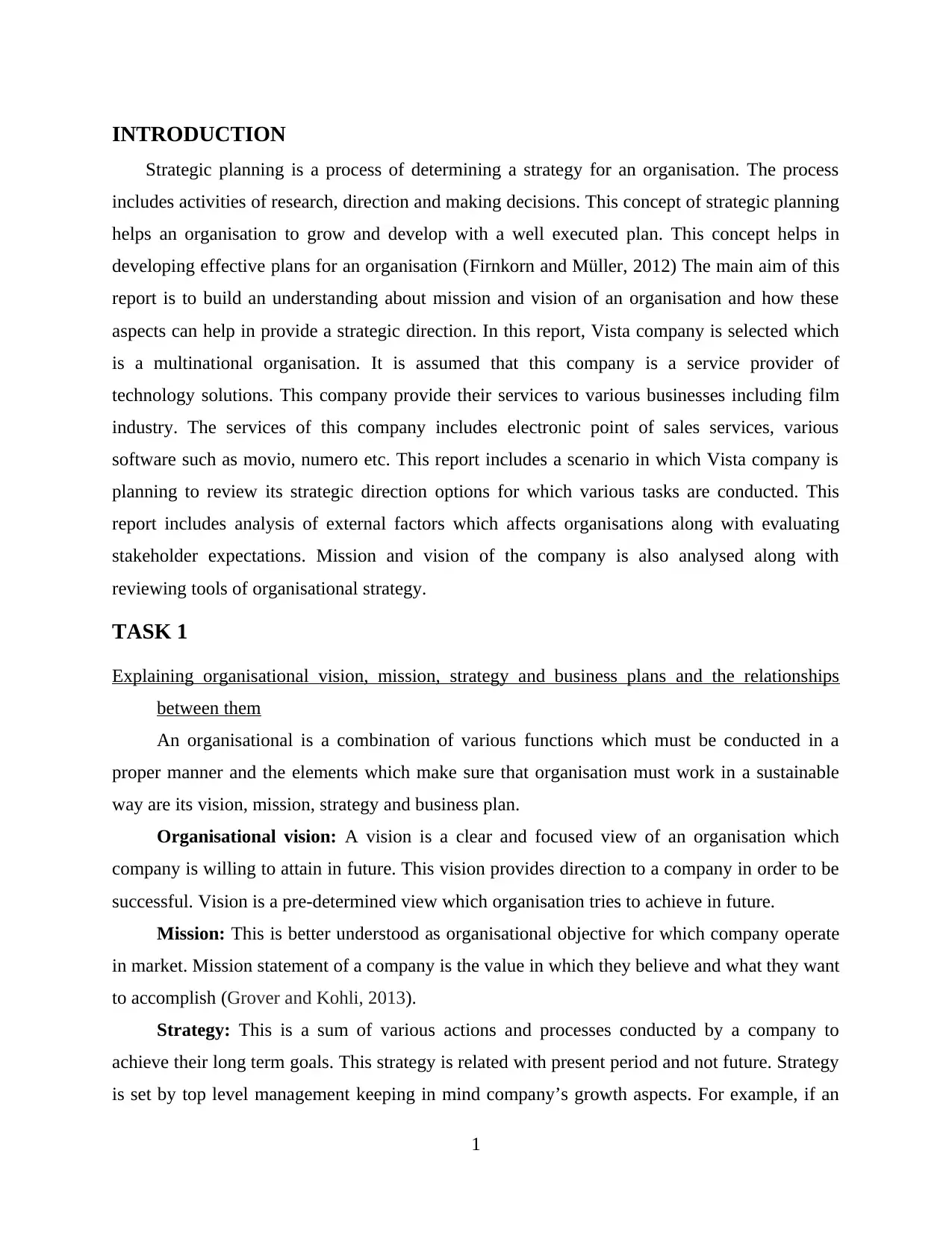
INTRODUCTION
Strategic planning is a process of determining a strategy for an organisation. The process
includes activities of research, direction and making decisions. This concept of strategic planning
helps an organisation to grow and develop with a well executed plan. This concept helps in
developing effective plans for an organisation (Firnkorn and Müller, 2012) The main aim of this
report is to build an understanding about mission and vision of an organisation and how these
aspects can help in provide a strategic direction. In this report, Vista company is selected which
is a multinational organisation. It is assumed that this company is a service provider of
technology solutions. This company provide their services to various businesses including film
industry. The services of this company includes electronic point of sales services, various
software such as movio, numero etc. This report includes a scenario in which Vista company is
planning to review its strategic direction options for which various tasks are conducted. This
report includes analysis of external factors which affects organisations along with evaluating
stakeholder expectations. Mission and vision of the company is also analysed along with
reviewing tools of organisational strategy.
TASK 1
Explaining organisational vision, mission, strategy and business plans and the relationships
between them
An organisational is a combination of various functions which must be conducted in a
proper manner and the elements which make sure that organisation must work in a sustainable
way are its vision, mission, strategy and business plan.
Organisational vision: A vision is a clear and focused view of an organisation which
company is willing to attain in future. This vision provides direction to a company in order to be
successful. Vision is a pre-determined view which organisation tries to achieve in future.
Mission: This is better understood as organisational objective for which company operate
in market. Mission statement of a company is the value in which they believe and what they want
to accomplish (Grover and Kohli, 2013).
Strategy: This is a sum of various actions and processes conducted by a company to
achieve their long term goals. This strategy is related with present period and not future. Strategy
is set by top level management keeping in mind company’s growth aspects. For example, if an
1
Strategic planning is a process of determining a strategy for an organisation. The process
includes activities of research, direction and making decisions. This concept of strategic planning
helps an organisation to grow and develop with a well executed plan. This concept helps in
developing effective plans for an organisation (Firnkorn and Müller, 2012) The main aim of this
report is to build an understanding about mission and vision of an organisation and how these
aspects can help in provide a strategic direction. In this report, Vista company is selected which
is a multinational organisation. It is assumed that this company is a service provider of
technology solutions. This company provide their services to various businesses including film
industry. The services of this company includes electronic point of sales services, various
software such as movio, numero etc. This report includes a scenario in which Vista company is
planning to review its strategic direction options for which various tasks are conducted. This
report includes analysis of external factors which affects organisations along with evaluating
stakeholder expectations. Mission and vision of the company is also analysed along with
reviewing tools of organisational strategy.
TASK 1
Explaining organisational vision, mission, strategy and business plans and the relationships
between them
An organisational is a combination of various functions which must be conducted in a
proper manner and the elements which make sure that organisation must work in a sustainable
way are its vision, mission, strategy and business plan.
Organisational vision: A vision is a clear and focused view of an organisation which
company is willing to attain in future. This vision provides direction to a company in order to be
successful. Vision is a pre-determined view which organisation tries to achieve in future.
Mission: This is better understood as organisational objective for which company operate
in market. Mission statement of a company is the value in which they believe and what they want
to accomplish (Grover and Kohli, 2013).
Strategy: This is a sum of various actions and processes conducted by a company to
achieve their long term goals. This strategy is related with present period and not future. Strategy
is set by top level management keeping in mind company’s growth aspects. For example, if an
1
Paraphrase This Document
Need a fresh take? Get an instant paraphrase of this document with our AI Paraphraser
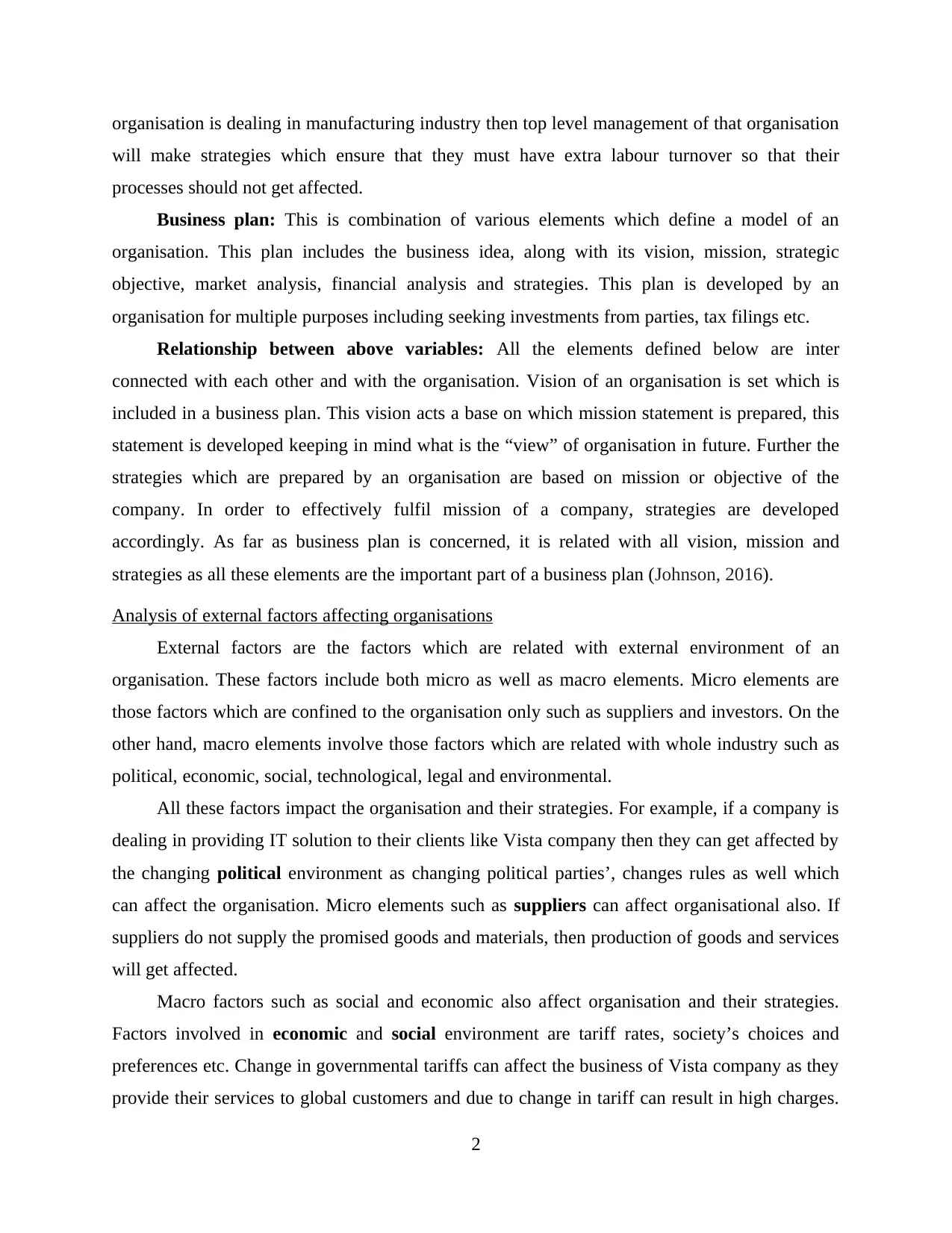
organisation is dealing in manufacturing industry then top level management of that organisation
will make strategies which ensure that they must have extra labour turnover so that their
processes should not get affected.
Business plan: This is combination of various elements which define a model of an
organisation. This plan includes the business idea, along with its vision, mission, strategic
objective, market analysis, financial analysis and strategies. This plan is developed by an
organisation for multiple purposes including seeking investments from parties, tax filings etc.
Relationship between above variables: All the elements defined below are inter
connected with each other and with the organisation. Vision of an organisation is set which is
included in a business plan. This vision acts a base on which mission statement is prepared, this
statement is developed keeping in mind what is the “view” of organisation in future. Further the
strategies which are prepared by an organisation are based on mission or objective of the
company. In order to effectively fulfil mission of a company, strategies are developed
accordingly. As far as business plan is concerned, it is related with all vision, mission and
strategies as all these elements are the important part of a business plan (Johnson, 2016).
Analysis of external factors affecting organisations
External factors are the factors which are related with external environment of an
organisation. These factors include both micro as well as macro elements. Micro elements are
those factors which are confined to the organisation only such as suppliers and investors. On the
other hand, macro elements involve those factors which are related with whole industry such as
political, economic, social, technological, legal and environmental.
All these factors impact the organisation and their strategies. For example, if a company is
dealing in providing IT solution to their clients like Vista company then they can get affected by
the changing political environment as changing political parties’, changes rules as well which
can affect the organisation. Micro elements such as suppliers can affect organisational also. If
suppliers do not supply the promised goods and materials, then production of goods and services
will get affected.
Macro factors such as social and economic also affect organisation and their strategies.
Factors involved in economic and social environment are tariff rates, society’s choices and
preferences etc. Change in governmental tariffs can affect the business of Vista company as they
provide their services to global customers and due to change in tariff can result in high charges.
2
will make strategies which ensure that they must have extra labour turnover so that their
processes should not get affected.
Business plan: This is combination of various elements which define a model of an
organisation. This plan includes the business idea, along with its vision, mission, strategic
objective, market analysis, financial analysis and strategies. This plan is developed by an
organisation for multiple purposes including seeking investments from parties, tax filings etc.
Relationship between above variables: All the elements defined below are inter
connected with each other and with the organisation. Vision of an organisation is set which is
included in a business plan. This vision acts a base on which mission statement is prepared, this
statement is developed keeping in mind what is the “view” of organisation in future. Further the
strategies which are prepared by an organisation are based on mission or objective of the
company. In order to effectively fulfil mission of a company, strategies are developed
accordingly. As far as business plan is concerned, it is related with all vision, mission and
strategies as all these elements are the important part of a business plan (Johnson, 2016).
Analysis of external factors affecting organisations
External factors are the factors which are related with external environment of an
organisation. These factors include both micro as well as macro elements. Micro elements are
those factors which are confined to the organisation only such as suppliers and investors. On the
other hand, macro elements involve those factors which are related with whole industry such as
political, economic, social, technological, legal and environmental.
All these factors impact the organisation and their strategies. For example, if a company is
dealing in providing IT solution to their clients like Vista company then they can get affected by
the changing political environment as changing political parties’, changes rules as well which
can affect the organisation. Micro elements such as suppliers can affect organisational also. If
suppliers do not supply the promised goods and materials, then production of goods and services
will get affected.
Macro factors such as social and economic also affect organisation and their strategies.
Factors involved in economic and social environment are tariff rates, society’s choices and
preferences etc. Change in governmental tariffs can affect the business of Vista company as they
provide their services to global customers and due to change in tariff can result in high charges.
2
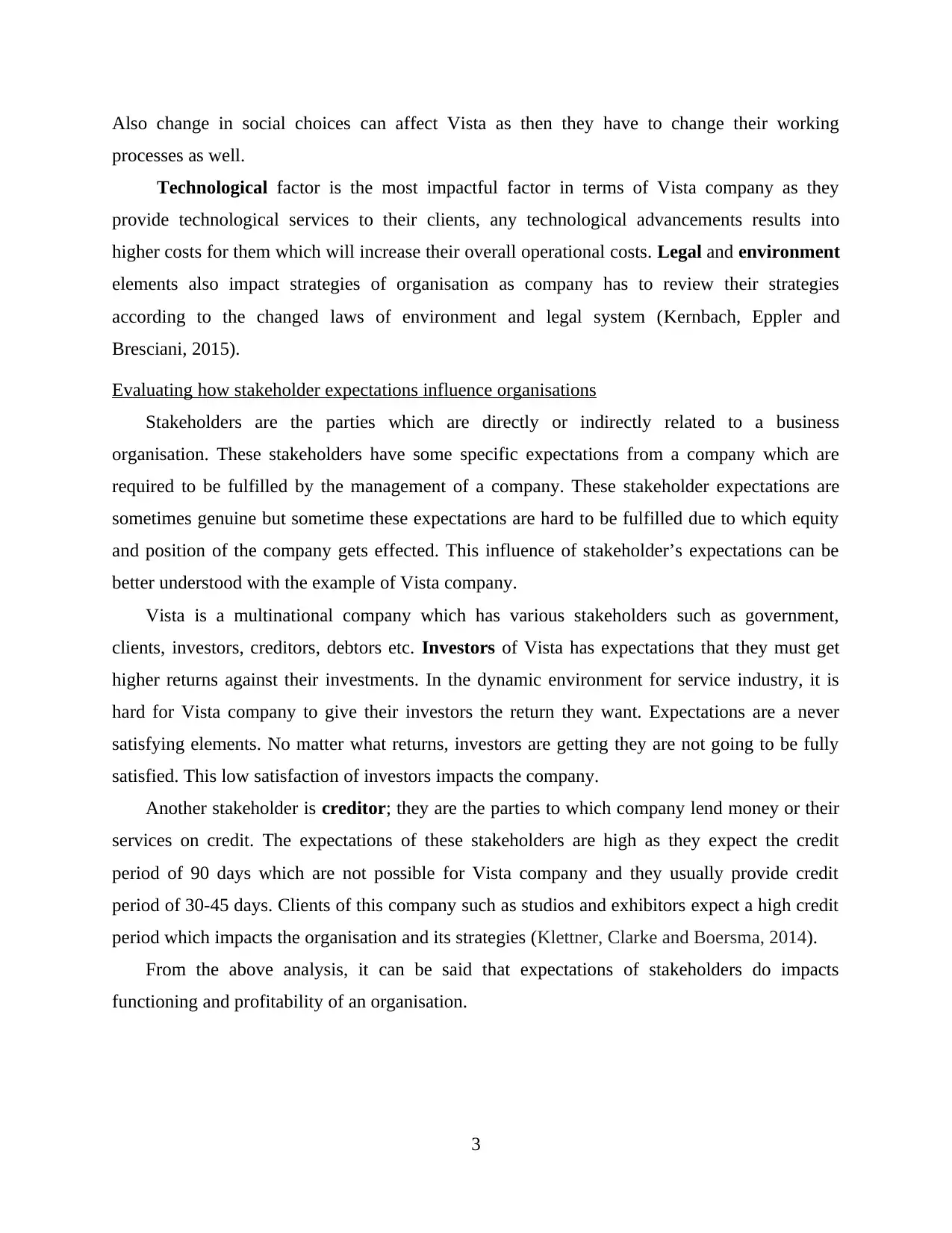
Also change in social choices can affect Vista as then they have to change their working
processes as well.
Technological factor is the most impactful factor in terms of Vista company as they
provide technological services to their clients, any technological advancements results into
higher costs for them which will increase their overall operational costs. Legal and environment
elements also impact strategies of organisation as company has to review their strategies
according to the changed laws of environment and legal system (Kernbach, Eppler and
Bresciani, 2015).
Evaluating how stakeholder expectations influence organisations
Stakeholders are the parties which are directly or indirectly related to a business
organisation. These stakeholders have some specific expectations from a company which are
required to be fulfilled by the management of a company. These stakeholder expectations are
sometimes genuine but sometime these expectations are hard to be fulfilled due to which equity
and position of the company gets effected. This influence of stakeholder’s expectations can be
better understood with the example of Vista company.
Vista is a multinational company which has various stakeholders such as government,
clients, investors, creditors, debtors etc. Investors of Vista has expectations that they must get
higher returns against their investments. In the dynamic environment for service industry, it is
hard for Vista company to give their investors the return they want. Expectations are a never
satisfying elements. No matter what returns, investors are getting they are not going to be fully
satisfied. This low satisfaction of investors impacts the company.
Another stakeholder is creditor; they are the parties to which company lend money or their
services on credit. The expectations of these stakeholders are high as they expect the credit
period of 90 days which are not possible for Vista company and they usually provide credit
period of 30-45 days. Clients of this company such as studios and exhibitors expect a high credit
period which impacts the organisation and its strategies (Klettner, Clarke and Boersma, 2014).
From the above analysis, it can be said that expectations of stakeholders do impacts
functioning and profitability of an organisation.
3
processes as well.
Technological factor is the most impactful factor in terms of Vista company as they
provide technological services to their clients, any technological advancements results into
higher costs for them which will increase their overall operational costs. Legal and environment
elements also impact strategies of organisation as company has to review their strategies
according to the changed laws of environment and legal system (Kernbach, Eppler and
Bresciani, 2015).
Evaluating how stakeholder expectations influence organisations
Stakeholders are the parties which are directly or indirectly related to a business
organisation. These stakeholders have some specific expectations from a company which are
required to be fulfilled by the management of a company. These stakeholder expectations are
sometimes genuine but sometime these expectations are hard to be fulfilled due to which equity
and position of the company gets effected. This influence of stakeholder’s expectations can be
better understood with the example of Vista company.
Vista is a multinational company which has various stakeholders such as government,
clients, investors, creditors, debtors etc. Investors of Vista has expectations that they must get
higher returns against their investments. In the dynamic environment for service industry, it is
hard for Vista company to give their investors the return they want. Expectations are a never
satisfying elements. No matter what returns, investors are getting they are not going to be fully
satisfied. This low satisfaction of investors impacts the company.
Another stakeholder is creditor; they are the parties to which company lend money or their
services on credit. The expectations of these stakeholders are high as they expect the credit
period of 90 days which are not possible for Vista company and they usually provide credit
period of 30-45 days. Clients of this company such as studios and exhibitors expect a high credit
period which impacts the organisation and its strategies (Klettner, Clarke and Boersma, 2014).
From the above analysis, it can be said that expectations of stakeholders do impacts
functioning and profitability of an organisation.
3
⊘ This is a preview!⊘
Do you want full access?
Subscribe today to unlock all pages.

Trusted by 1+ million students worldwide
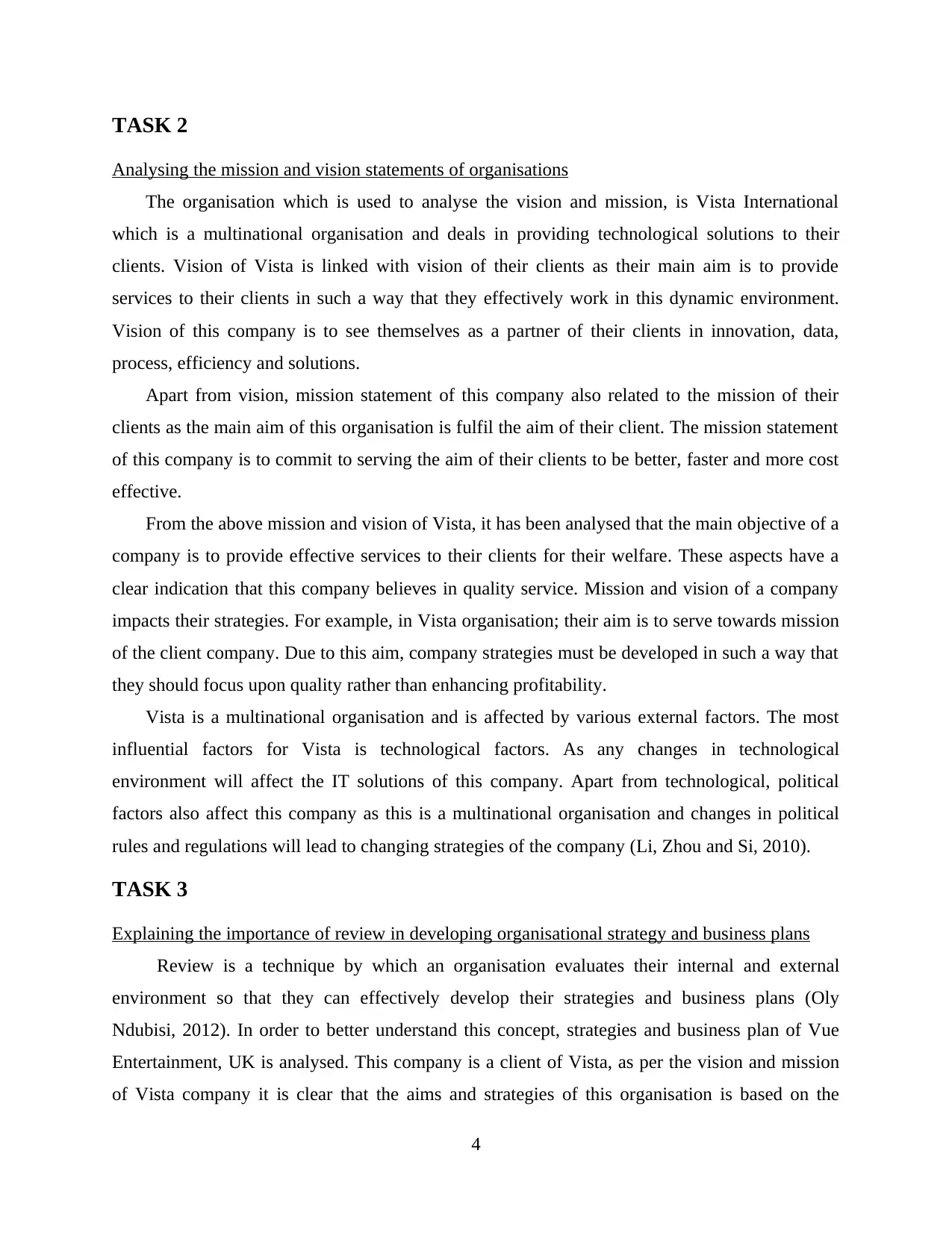
TASK 2
Analysing the mission and vision statements of organisations
The organisation which is used to analyse the vision and mission, is Vista International
which is a multinational organisation and deals in providing technological solutions to their
clients. Vision of Vista is linked with vision of their clients as their main aim is to provide
services to their clients in such a way that they effectively work in this dynamic environment.
Vision of this company is to see themselves as a partner of their clients in innovation, data,
process, efficiency and solutions.
Apart from vision, mission statement of this company also related to the mission of their
clients as the main aim of this organisation is fulfil the aim of their client. The mission statement
of this company is to commit to serving the aim of their clients to be better, faster and more cost
effective.
From the above mission and vision of Vista, it has been analysed that the main objective of a
company is to provide effective services to their clients for their welfare. These aspects have a
clear indication that this company believes in quality service. Mission and vision of a company
impacts their strategies. For example, in Vista organisation; their aim is to serve towards mission
of the client company. Due to this aim, company strategies must be developed in such a way that
they should focus upon quality rather than enhancing profitability.
Vista is a multinational organisation and is affected by various external factors. The most
influential factors for Vista is technological factors. As any changes in technological
environment will affect the IT solutions of this company. Apart from technological, political
factors also affect this company as this is a multinational organisation and changes in political
rules and regulations will lead to changing strategies of the company (Li, Zhou and Si, 2010).
TASK 3
Explaining the importance of review in developing organisational strategy and business plans
Review is a technique by which an organisation evaluates their internal and external
environment so that they can effectively develop their strategies and business plans (Oly
Ndubisi, 2012). In order to better understand this concept, strategies and business plan of Vue
Entertainment, UK is analysed. This company is a client of Vista, as per the vision and mission
of Vista company it is clear that the aims and strategies of this organisation is based on the
4
Analysing the mission and vision statements of organisations
The organisation which is used to analyse the vision and mission, is Vista International
which is a multinational organisation and deals in providing technological solutions to their
clients. Vision of Vista is linked with vision of their clients as their main aim is to provide
services to their clients in such a way that they effectively work in this dynamic environment.
Vision of this company is to see themselves as a partner of their clients in innovation, data,
process, efficiency and solutions.
Apart from vision, mission statement of this company also related to the mission of their
clients as the main aim of this organisation is fulfil the aim of their client. The mission statement
of this company is to commit to serving the aim of their clients to be better, faster and more cost
effective.
From the above mission and vision of Vista, it has been analysed that the main objective of a
company is to provide effective services to their clients for their welfare. These aspects have a
clear indication that this company believes in quality service. Mission and vision of a company
impacts their strategies. For example, in Vista organisation; their aim is to serve towards mission
of the client company. Due to this aim, company strategies must be developed in such a way that
they should focus upon quality rather than enhancing profitability.
Vista is a multinational organisation and is affected by various external factors. The most
influential factors for Vista is technological factors. As any changes in technological
environment will affect the IT solutions of this company. Apart from technological, political
factors also affect this company as this is a multinational organisation and changes in political
rules and regulations will lead to changing strategies of the company (Li, Zhou and Si, 2010).
TASK 3
Explaining the importance of review in developing organisational strategy and business plans
Review is a technique by which an organisation evaluates their internal and external
environment so that they can effectively develop their strategies and business plans (Oly
Ndubisi, 2012). In order to better understand this concept, strategies and business plan of Vue
Entertainment, UK is analysed. This company is a client of Vista, as per the vision and mission
of Vista company it is clear that the aims and strategies of this organisation is based on the
4
Paraphrase This Document
Need a fresh take? Get an instant paraphrase of this document with our AI Paraphraser
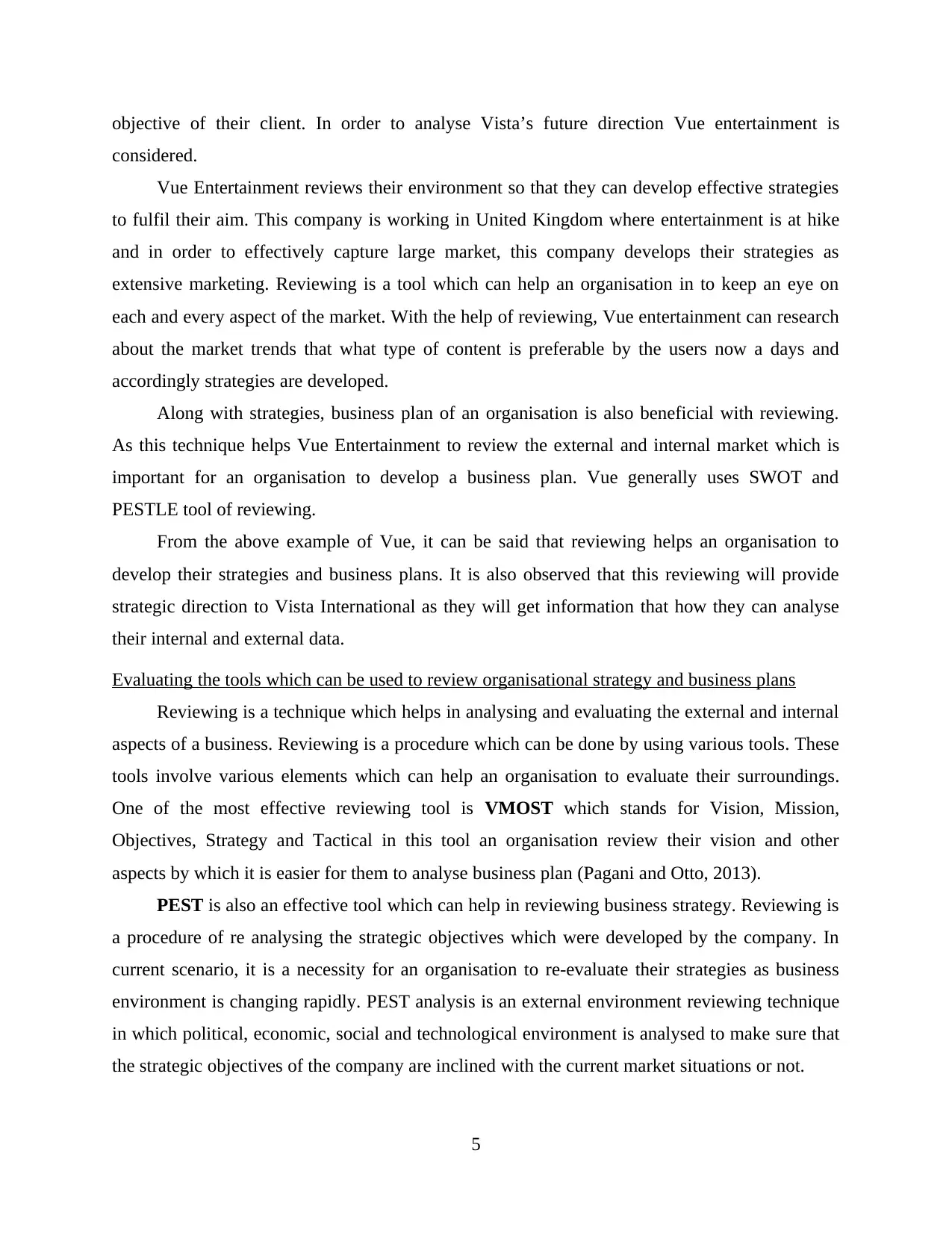
objective of their client. In order to analyse Vista’s future direction Vue entertainment is
considered.
Vue Entertainment reviews their environment so that they can develop effective strategies
to fulfil their aim. This company is working in United Kingdom where entertainment is at hike
and in order to effectively capture large market, this company develops their strategies as
extensive marketing. Reviewing is a tool which can help an organisation in to keep an eye on
each and every aspect of the market. With the help of reviewing, Vue entertainment can research
about the market trends that what type of content is preferable by the users now a days and
accordingly strategies are developed.
Along with strategies, business plan of an organisation is also beneficial with reviewing.
As this technique helps Vue Entertainment to review the external and internal market which is
important for an organisation to develop a business plan. Vue generally uses SWOT and
PESTLE tool of reviewing.
From the above example of Vue, it can be said that reviewing helps an organisation to
develop their strategies and business plans. It is also observed that this reviewing will provide
strategic direction to Vista International as they will get information that how they can analyse
their internal and external data.
Evaluating the tools which can be used to review organisational strategy and business plans
Reviewing is a technique which helps in analysing and evaluating the external and internal
aspects of a business. Reviewing is a procedure which can be done by using various tools. These
tools involve various elements which can help an organisation to evaluate their surroundings.
One of the most effective reviewing tool is VMOST which stands for Vision, Mission,
Objectives, Strategy and Tactical in this tool an organisation review their vision and other
aspects by which it is easier for them to analyse business plan (Pagani and Otto, 2013).
PEST is also an effective tool which can help in reviewing business strategy. Reviewing is
a procedure of re analysing the strategic objectives which were developed by the company. In
current scenario, it is a necessity for an organisation to re-evaluate their strategies as business
environment is changing rapidly. PEST analysis is an external environment reviewing technique
in which political, economic, social and technological environment is analysed to make sure that
the strategic objectives of the company are inclined with the current market situations or not.
5
considered.
Vue Entertainment reviews their environment so that they can develop effective strategies
to fulfil their aim. This company is working in United Kingdom where entertainment is at hike
and in order to effectively capture large market, this company develops their strategies as
extensive marketing. Reviewing is a tool which can help an organisation in to keep an eye on
each and every aspect of the market. With the help of reviewing, Vue entertainment can research
about the market trends that what type of content is preferable by the users now a days and
accordingly strategies are developed.
Along with strategies, business plan of an organisation is also beneficial with reviewing.
As this technique helps Vue Entertainment to review the external and internal market which is
important for an organisation to develop a business plan. Vue generally uses SWOT and
PESTLE tool of reviewing.
From the above example of Vue, it can be said that reviewing helps an organisation to
develop their strategies and business plans. It is also observed that this reviewing will provide
strategic direction to Vista International as they will get information that how they can analyse
their internal and external data.
Evaluating the tools which can be used to review organisational strategy and business plans
Reviewing is a technique which helps in analysing and evaluating the external and internal
aspects of a business. Reviewing is a procedure which can be done by using various tools. These
tools involve various elements which can help an organisation to evaluate their surroundings.
One of the most effective reviewing tool is VMOST which stands for Vision, Mission,
Objectives, Strategy and Tactical in this tool an organisation review their vision and other
aspects by which it is easier for them to analyse business plan (Pagani and Otto, 2013).
PEST is also an effective tool which can help in reviewing business strategy. Reviewing is
a procedure of re analysing the strategic objectives which were developed by the company. In
current scenario, it is a necessity for an organisation to re-evaluate their strategies as business
environment is changing rapidly. PEST analysis is an external environment reviewing technique
in which political, economic, social and technological environment is analysed to make sure that
the strategic objectives of the company are inclined with the current market situations or not.
5
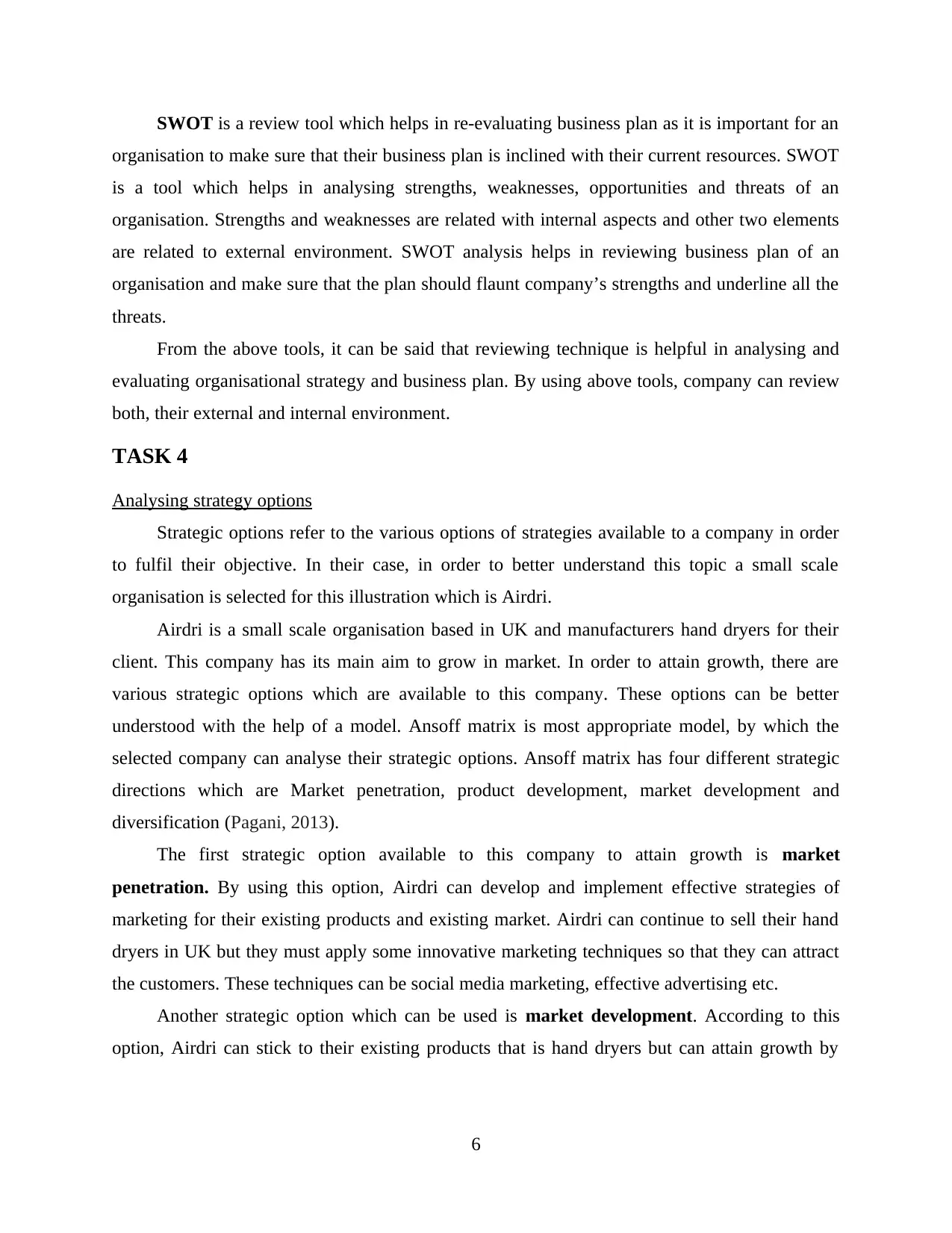
SWOT is a review tool which helps in re-evaluating business plan as it is important for an
organisation to make sure that their business plan is inclined with their current resources. SWOT
is a tool which helps in analysing strengths, weaknesses, opportunities and threats of an
organisation. Strengths and weaknesses are related with internal aspects and other two elements
are related to external environment. SWOT analysis helps in reviewing business plan of an
organisation and make sure that the plan should flaunt company’s strengths and underline all the
threats.
From the above tools, it can be said that reviewing technique is helpful in analysing and
evaluating organisational strategy and business plan. By using above tools, company can review
both, their external and internal environment.
TASK 4
Analysing strategy options
Strategic options refer to the various options of strategies available to a company in order
to fulfil their objective. In their case, in order to better understand this topic a small scale
organisation is selected for this illustration which is Airdri.
Airdri is a small scale organisation based in UK and manufacturers hand dryers for their
client. This company has its main aim to grow in market. In order to attain growth, there are
various strategic options which are available to this company. These options can be better
understood with the help of a model. Ansoff matrix is most appropriate model, by which the
selected company can analyse their strategic options. Ansoff matrix has four different strategic
directions which are Market penetration, product development, market development and
diversification (Pagani, 2013).
The first strategic option available to this company to attain growth is market
penetration. By using this option, Airdri can develop and implement effective strategies of
marketing for their existing products and existing market. Airdri can continue to sell their hand
dryers in UK but they must apply some innovative marketing techniques so that they can attract
the customers. These techniques can be social media marketing, effective advertising etc.
Another strategic option which can be used is market development. According to this
option, Airdri can stick to their existing products that is hand dryers but can attain growth by
6
organisation to make sure that their business plan is inclined with their current resources. SWOT
is a tool which helps in analysing strengths, weaknesses, opportunities and threats of an
organisation. Strengths and weaknesses are related with internal aspects and other two elements
are related to external environment. SWOT analysis helps in reviewing business plan of an
organisation and make sure that the plan should flaunt company’s strengths and underline all the
threats.
From the above tools, it can be said that reviewing technique is helpful in analysing and
evaluating organisational strategy and business plan. By using above tools, company can review
both, their external and internal environment.
TASK 4
Analysing strategy options
Strategic options refer to the various options of strategies available to a company in order
to fulfil their objective. In their case, in order to better understand this topic a small scale
organisation is selected for this illustration which is Airdri.
Airdri is a small scale organisation based in UK and manufacturers hand dryers for their
client. This company has its main aim to grow in market. In order to attain growth, there are
various strategic options which are available to this company. These options can be better
understood with the help of a model. Ansoff matrix is most appropriate model, by which the
selected company can analyse their strategic options. Ansoff matrix has four different strategic
directions which are Market penetration, product development, market development and
diversification (Pagani, 2013).
The first strategic option available to this company to attain growth is market
penetration. By using this option, Airdri can develop and implement effective strategies of
marketing for their existing products and existing market. Airdri can continue to sell their hand
dryers in UK but they must apply some innovative marketing techniques so that they can attract
the customers. These techniques can be social media marketing, effective advertising etc.
Another strategic option which can be used is market development. According to this
option, Airdri can stick to their existing products that is hand dryers but can attain growth by
6
⊘ This is a preview!⊘
Do you want full access?
Subscribe today to unlock all pages.

Trusted by 1+ million students worldwide
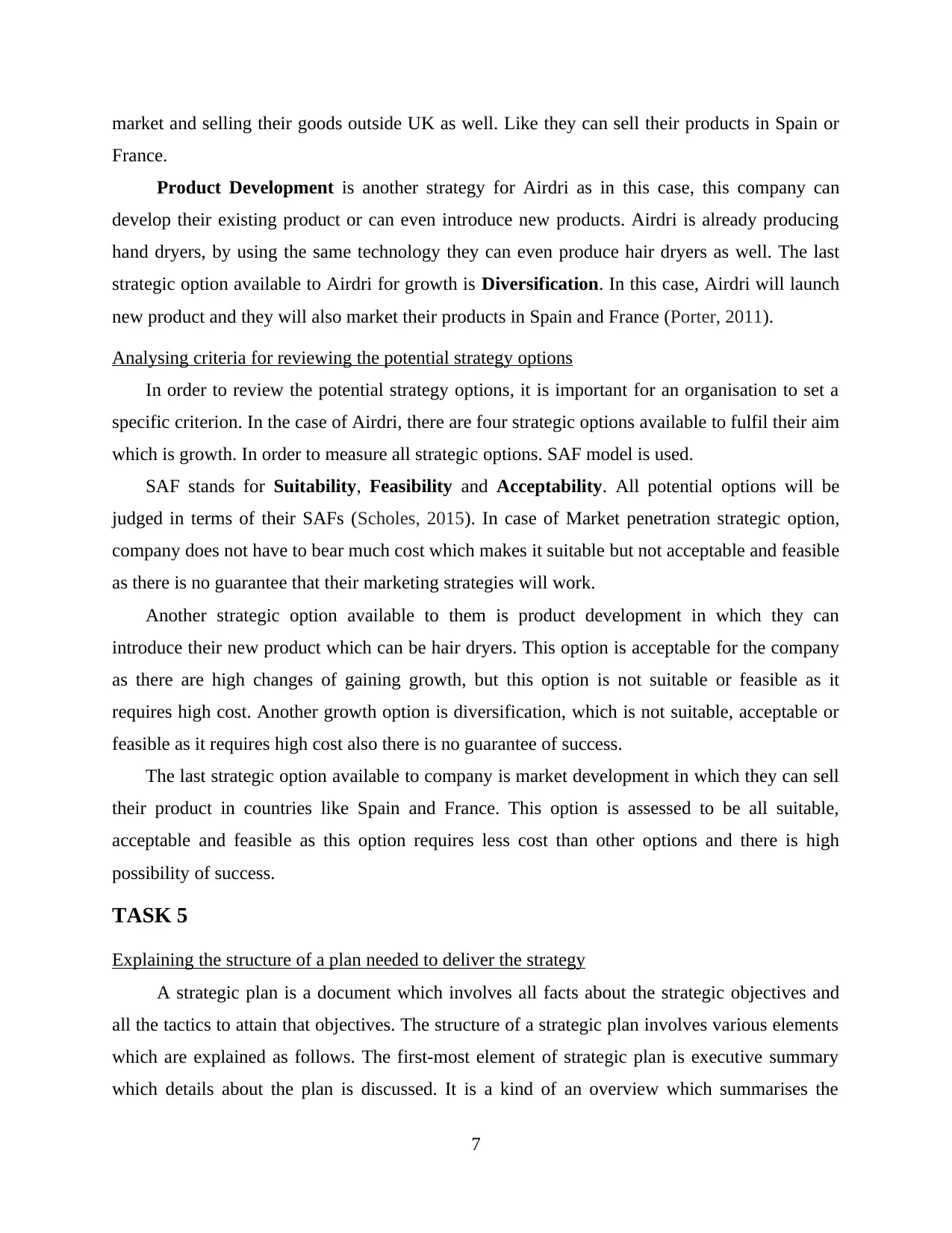
market and selling their goods outside UK as well. Like they can sell their products in Spain or
France.
Product Development is another strategy for Airdri as in this case, this company can
develop their existing product or can even introduce new products. Airdri is already producing
hand dryers, by using the same technology they can even produce hair dryers as well. The last
strategic option available to Airdri for growth is Diversification. In this case, Airdri will launch
new product and they will also market their products in Spain and France (Porter, 2011).
Analysing criteria for reviewing the potential strategy options
In order to review the potential strategy options, it is important for an organisation to set a
specific criterion. In the case of Airdri, there are four strategic options available to fulfil their aim
which is growth. In order to measure all strategic options. SAF model is used.
SAF stands for Suitability, Feasibility and Acceptability. All potential options will be
judged in terms of their SAFs (Scholes, 2015). In case of Market penetration strategic option,
company does not have to bear much cost which makes it suitable but not acceptable and feasible
as there is no guarantee that their marketing strategies will work.
Another strategic option available to them is product development in which they can
introduce their new product which can be hair dryers. This option is acceptable for the company
as there are high changes of gaining growth, but this option is not suitable or feasible as it
requires high cost. Another growth option is diversification, which is not suitable, acceptable or
feasible as it requires high cost also there is no guarantee of success.
The last strategic option available to company is market development in which they can sell
their product in countries like Spain and France. This option is assessed to be all suitable,
acceptable and feasible as this option requires less cost than other options and there is high
possibility of success.
TASK 5
Explaining the structure of a plan needed to deliver the strategy
A strategic plan is a document which involves all facts about the strategic objectives and
all the tactics to attain that objectives. The structure of a strategic plan involves various elements
which are explained as follows. The first-most element of strategic plan is executive summary
which details about the plan is discussed. It is a kind of an overview which summarises the
7
France.
Product Development is another strategy for Airdri as in this case, this company can
develop their existing product or can even introduce new products. Airdri is already producing
hand dryers, by using the same technology they can even produce hair dryers as well. The last
strategic option available to Airdri for growth is Diversification. In this case, Airdri will launch
new product and they will also market their products in Spain and France (Porter, 2011).
Analysing criteria for reviewing the potential strategy options
In order to review the potential strategy options, it is important for an organisation to set a
specific criterion. In the case of Airdri, there are four strategic options available to fulfil their aim
which is growth. In order to measure all strategic options. SAF model is used.
SAF stands for Suitability, Feasibility and Acceptability. All potential options will be
judged in terms of their SAFs (Scholes, 2015). In case of Market penetration strategic option,
company does not have to bear much cost which makes it suitable but not acceptable and feasible
as there is no guarantee that their marketing strategies will work.
Another strategic option available to them is product development in which they can
introduce their new product which can be hair dryers. This option is acceptable for the company
as there are high changes of gaining growth, but this option is not suitable or feasible as it
requires high cost. Another growth option is diversification, which is not suitable, acceptable or
feasible as it requires high cost also there is no guarantee of success.
The last strategic option available to company is market development in which they can sell
their product in countries like Spain and France. This option is assessed to be all suitable,
acceptable and feasible as this option requires less cost than other options and there is high
possibility of success.
TASK 5
Explaining the structure of a plan needed to deliver the strategy
A strategic plan is a document which involves all facts about the strategic objectives and
all the tactics to attain that objectives. The structure of a strategic plan involves various elements
which are explained as follows. The first-most element of strategic plan is executive summary
which details about the plan is discussed. It is a kind of an overview which summarises the
7
Paraphrase This Document
Need a fresh take? Get an instant paraphrase of this document with our AI Paraphraser
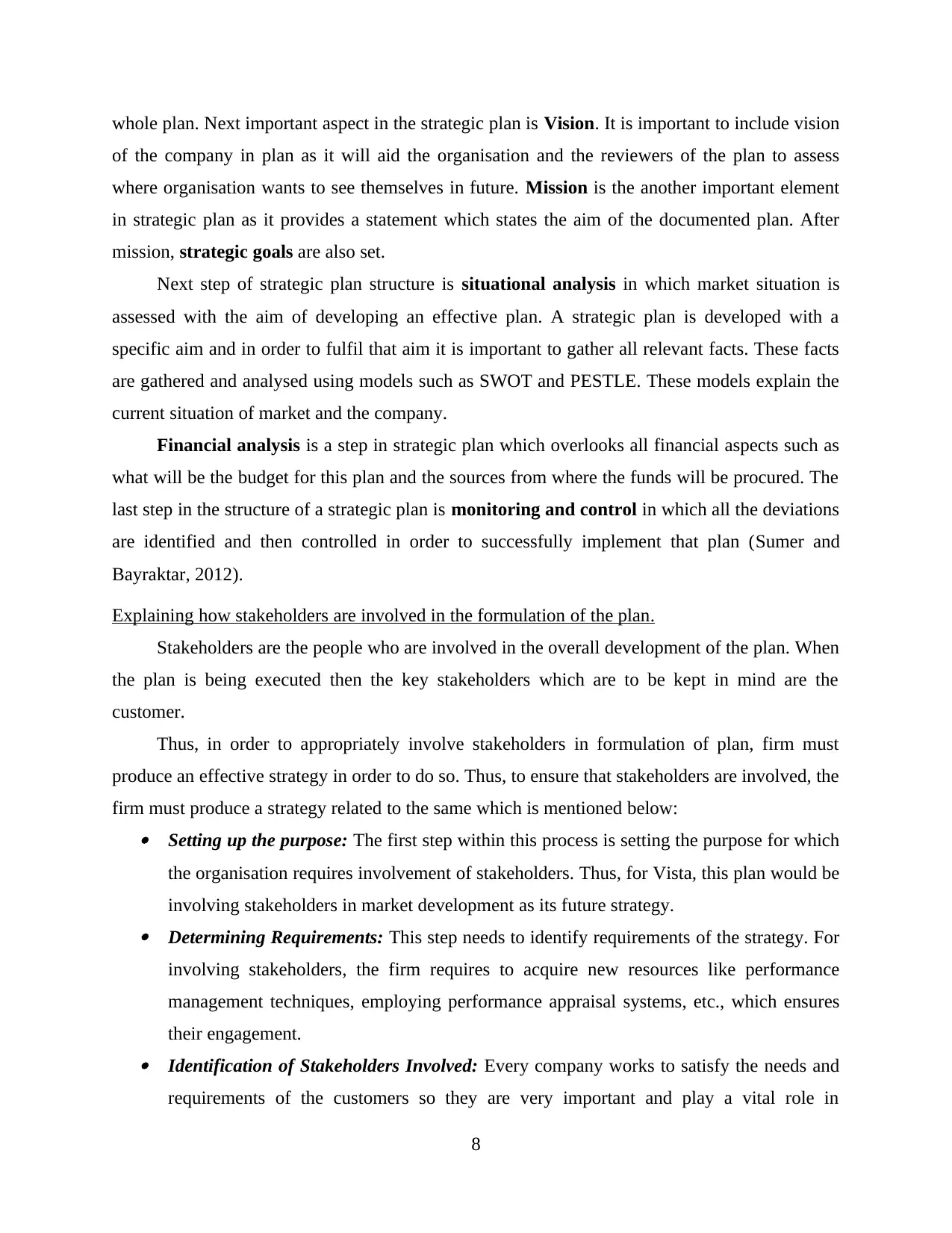
whole plan. Next important aspect in the strategic plan is Vision. It is important to include vision
of the company in plan as it will aid the organisation and the reviewers of the plan to assess
where organisation wants to see themselves in future. Mission is the another important element
in strategic plan as it provides a statement which states the aim of the documented plan. After
mission, strategic goals are also set.
Next step of strategic plan structure is situational analysis in which market situation is
assessed with the aim of developing an effective plan. A strategic plan is developed with a
specific aim and in order to fulfil that aim it is important to gather all relevant facts. These facts
are gathered and analysed using models such as SWOT and PESTLE. These models explain the
current situation of market and the company.
Financial analysis is a step in strategic plan which overlooks all financial aspects such as
what will be the budget for this plan and the sources from where the funds will be procured. The
last step in the structure of a strategic plan is monitoring and control in which all the deviations
are identified and then controlled in order to successfully implement that plan (Sumer and
Bayraktar, 2012).
Explaining how stakeholders are involved in the formulation of the plan.
Stakeholders are the people who are involved in the overall development of the plan. When
the plan is being executed then the key stakeholders which are to be kept in mind are the
customer.
Thus, in order to appropriately involve stakeholders in formulation of plan, firm must
produce an effective strategy in order to do so. Thus, to ensure that stakeholders are involved, the
firm must produce a strategy related to the same which is mentioned below: Setting up the purpose: The first step within this process is setting the purpose for which
the organisation requires involvement of stakeholders. Thus, for Vista, this plan would be
involving stakeholders in market development as its future strategy. Determining Requirements: This step needs to identify requirements of the strategy. For
involving stakeholders, the firm requires to acquire new resources like performance
management techniques, employing performance appraisal systems, etc., which ensures
their engagement. Identification of Stakeholders Involved: Every company works to satisfy the needs and
requirements of the customers so they are very important and play a vital role in
8
of the company in plan as it will aid the organisation and the reviewers of the plan to assess
where organisation wants to see themselves in future. Mission is the another important element
in strategic plan as it provides a statement which states the aim of the documented plan. After
mission, strategic goals are also set.
Next step of strategic plan structure is situational analysis in which market situation is
assessed with the aim of developing an effective plan. A strategic plan is developed with a
specific aim and in order to fulfil that aim it is important to gather all relevant facts. These facts
are gathered and analysed using models such as SWOT and PESTLE. These models explain the
current situation of market and the company.
Financial analysis is a step in strategic plan which overlooks all financial aspects such as
what will be the budget for this plan and the sources from where the funds will be procured. The
last step in the structure of a strategic plan is monitoring and control in which all the deviations
are identified and then controlled in order to successfully implement that plan (Sumer and
Bayraktar, 2012).
Explaining how stakeholders are involved in the formulation of the plan.
Stakeholders are the people who are involved in the overall development of the plan. When
the plan is being executed then the key stakeholders which are to be kept in mind are the
customer.
Thus, in order to appropriately involve stakeholders in formulation of plan, firm must
produce an effective strategy in order to do so. Thus, to ensure that stakeholders are involved, the
firm must produce a strategy related to the same which is mentioned below: Setting up the purpose: The first step within this process is setting the purpose for which
the organisation requires involvement of stakeholders. Thus, for Vista, this plan would be
involving stakeholders in market development as its future strategy. Determining Requirements: This step needs to identify requirements of the strategy. For
involving stakeholders, the firm requires to acquire new resources like performance
management techniques, employing performance appraisal systems, etc., which ensures
their engagement. Identification of Stakeholders Involved: Every company works to satisfy the needs and
requirements of the customers so they are very important and play a vital role in
8
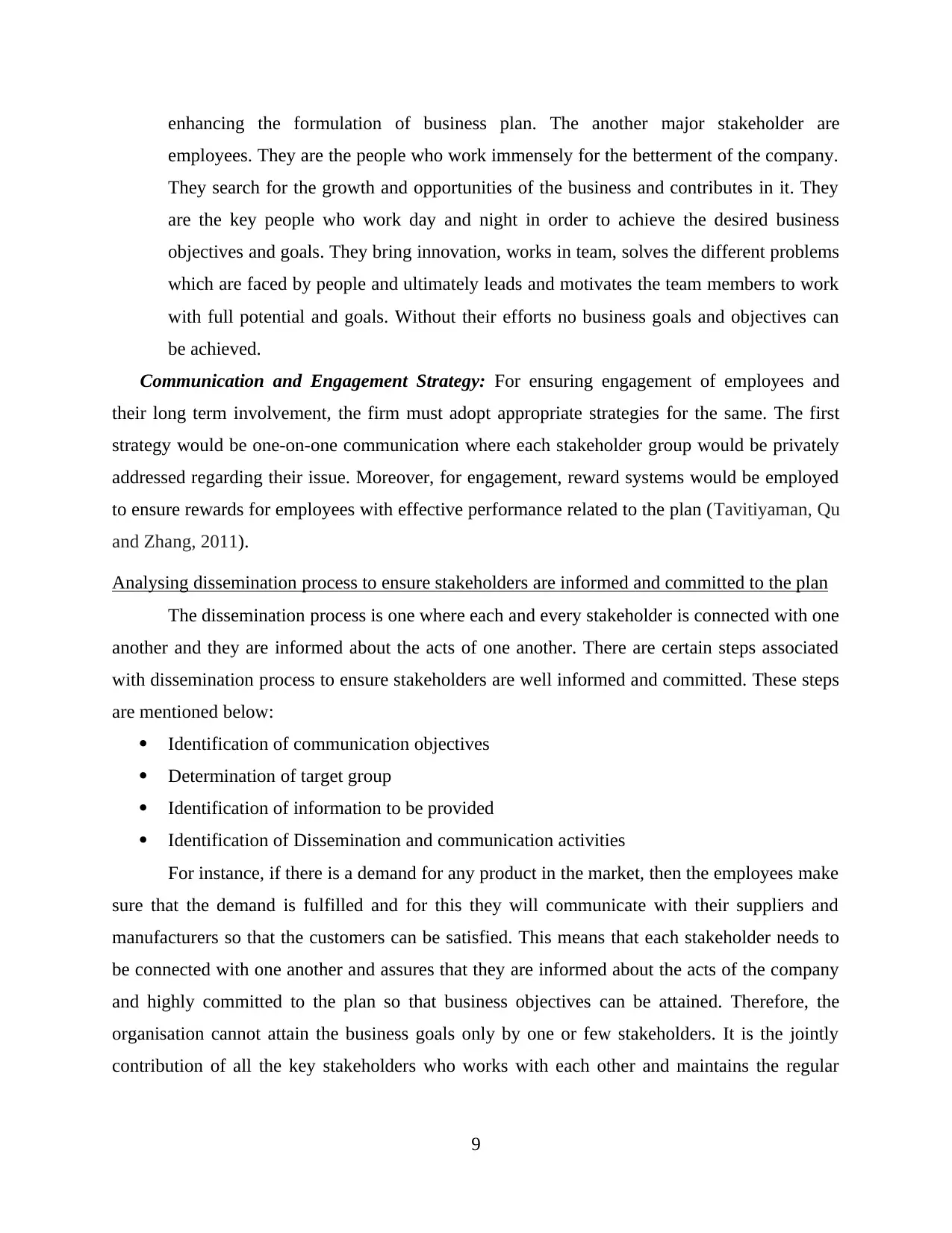
enhancing the formulation of business plan. The another major stakeholder are
employees. They are the people who work immensely for the betterment of the company.
They search for the growth and opportunities of the business and contributes in it. They
are the key people who work day and night in order to achieve the desired business
objectives and goals. They bring innovation, works in team, solves the different problems
which are faced by people and ultimately leads and motivates the team members to work
with full potential and goals. Without their efforts no business goals and objectives can
be achieved.
Communication and Engagement Strategy: For ensuring engagement of employees and
their long term involvement, the firm must adopt appropriate strategies for the same. The first
strategy would be one-on-one communication where each stakeholder group would be privately
addressed regarding their issue. Moreover, for engagement, reward systems would be employed
to ensure rewards for employees with effective performance related to the plan (Tavitiyaman, Qu
and Zhang, 2011).
Analysing dissemination process to ensure stakeholders are informed and committed to the plan
The dissemination process is one where each and every stakeholder is connected with one
another and they are informed about the acts of one another. There are certain steps associated
with dissemination process to ensure stakeholders are well informed and committed. These steps
are mentioned below:
Identification of communication objectives
Determination of target group
Identification of information to be provided
Identification of Dissemination and communication activities
For instance, if there is a demand for any product in the market, then the employees make
sure that the demand is fulfilled and for this they will communicate with their suppliers and
manufacturers so that the customers can be satisfied. This means that each stakeholder needs to
be connected with one another and assures that they are informed about the acts of the company
and highly committed to the plan so that business objectives can be attained. Therefore, the
organisation cannot attain the business goals only by one or few stakeholders. It is the jointly
contribution of all the key stakeholders who works with each other and maintains the regular
9
employees. They are the people who work immensely for the betterment of the company.
They search for the growth and opportunities of the business and contributes in it. They
are the key people who work day and night in order to achieve the desired business
objectives and goals. They bring innovation, works in team, solves the different problems
which are faced by people and ultimately leads and motivates the team members to work
with full potential and goals. Without their efforts no business goals and objectives can
be achieved.
Communication and Engagement Strategy: For ensuring engagement of employees and
their long term involvement, the firm must adopt appropriate strategies for the same. The first
strategy would be one-on-one communication where each stakeholder group would be privately
addressed regarding their issue. Moreover, for engagement, reward systems would be employed
to ensure rewards for employees with effective performance related to the plan (Tavitiyaman, Qu
and Zhang, 2011).
Analysing dissemination process to ensure stakeholders are informed and committed to the plan
The dissemination process is one where each and every stakeholder is connected with one
another and they are informed about the acts of one another. There are certain steps associated
with dissemination process to ensure stakeholders are well informed and committed. These steps
are mentioned below:
Identification of communication objectives
Determination of target group
Identification of information to be provided
Identification of Dissemination and communication activities
For instance, if there is a demand for any product in the market, then the employees make
sure that the demand is fulfilled and for this they will communicate with their suppliers and
manufacturers so that the customers can be satisfied. This means that each stakeholder needs to
be connected with one another and assures that they are informed about the acts of the company
and highly committed to the plan so that business objectives can be attained. Therefore, the
organisation cannot attain the business goals only by one or few stakeholders. It is the jointly
contribution of all the key stakeholders who works with each other and maintains the regular
9
⊘ This is a preview!⊘
Do you want full access?
Subscribe today to unlock all pages.

Trusted by 1+ million students worldwide
1 out of 15
Related Documents
Your All-in-One AI-Powered Toolkit for Academic Success.
+13062052269
info@desklib.com
Available 24*7 on WhatsApp / Email
![[object Object]](/_next/static/media/star-bottom.7253800d.svg)
Unlock your academic potential
Copyright © 2020–2025 A2Z Services. All Rights Reserved. Developed and managed by ZUCOL.




